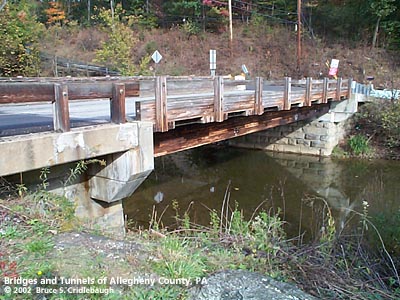| Home > All By Location regional map > Glenshaw > Elfinwild Rd over Pine Creek | |||
|
|

View northeast (downstream right) More detail photos OFFICIAL NAME: OTHER DESIGNATION: Elfinwild Rd over Pine Creek glen588-24 LOCATION: Shaler USGS 7.5" Topo Quad - UTM Coordinates: Glenshaw - Zone 17; 0588-4489 CARRIES: Elfinwild Rd BETWEEN: -- east of William Flinn Hwy [PA8] CROSSES: -- Pine Creek TYPE OF CONSTRUCTION / DESIGN: current span: glulam longitudinal stringers (glued laminated wooden beams) current deck: transverse wooden planks with bituminous road surface 1890 span: riveted steel plate girder [removed] 1890 abutments: locally-quarried sandstone, rock-faced coursed ashlar LENGTH OF MAIN SPAN: 56.6 ft TOTAL LENGTH (including longest elevated ramp): 84 ft est HEIGHT OF DECK: 6 ft est clearance 25 ft wide deck with 21 ft wide road surface; 4.5 ft sidewalk on upstream side YEAR ERECTED / ENGINEER: current span: c1996, glulam longitudinal stringers with transverse dimensional timber deck PennDOT? original span:1890, Allegheny County Charles Davis, engineer ADDITIONAL INFO: The current bridge carrying East Elfinwild Rd over Pine Creek is one of very few timber bridges in Allegheny County and probably the only local wooden structure carrying a motor vehicle road. The only other notable wooden bridges in the county are the railroad trestle at connecting the CSX railroad to the Carnegie Museum "Cloud Factory" boiler plant, and a wooden trestle for golf carts and pedestrians at Churchill Valley Country Club. This bridge at Elfinwild Rd is built on stone abutments built in 1890 for one of many girder span designed by Charles Davis for the county. When the girder span was removed, the bearing section of the abutment was enlarged to include a variation of the hammerhead pier form. This allowed the abutments to carry a wider span. Upon the hammerhead bearings rest four pairs of wooden beams. Running lengthwise in relation to the bridge, they are "longitudinal." Each beam (or stringer) is of made of a number of wooden pieces layered and glued together to form a larger beam. The layers are laid horizontally along the beam; these are "glulam stringers" -- glued laminated wooden beams. Each pair of stringers measures one foot wide by two feet, eight inches deep. The span is 56 feet, 8 inches long. Glulam beams are commonly made from softwoods like Southern Pine or Douglas Fir; this may be a Pine bridge over Pine Creek. PennDOT was also building timber bridges at other locations within Pennsylvania beginning in the mid 1990s. Some of those were experimenting with hardwoods such as Red Maple and Red Oak. PennDOT has published a set of standards for this type of bridge. Metal brackets with metal dowels hold glulam diaphragms (crossbraces) between the stringers. On top of the stringers, a series of eight-inch square dimensional timbers are laid transversely (across). A coating of asphalt pavement provides the road wearing surface. - - - - During years surrounding 1900, Allegheny County, under the direction of County Engineer Charles Davis, was busy throughout the county building stone arch bridges of a simple and similar design. In some places, however, the crossings were built as riveted plate girder spans. The abutments of these girder bridges exhibit similar stonework to the County's stone bridges -- helping to identify their place in time and origin. A glance at the construction dates indicates that many of the earlier bridge were of the girder type. One possible explanation for the choice of an arch span versus a girder span may be found in the shape of the land onsite. Where the stream has high banks and can therefore hold rising waters of a flash flood, the bridges are usually stone arches. In places with relatively wide, flat channels, the spans are most often girders. In each instance, the goal was to maintain the level of the road surface as the road approaches and then enters the bridge -- while allowing maximum potential stream flow; sites which made this impractical have since been regraded or replaced. FIELD CHECKED: 21-Oct-2002 INFO SOURCES: field check; apawood.org Engineered Wood Systems Submit info or inquiry - share some facts or ask a question. Introduction -- Nearby Structures Page created: Last modified: 20-Feb-2003 |
View Larger Map View Larger Map 
| |
| copyright: © Bruce S. Cridlebaugh 1999-2008 All Rights Reserved | |||